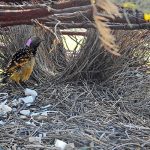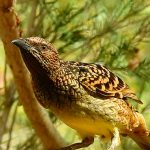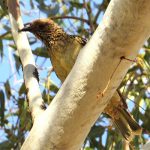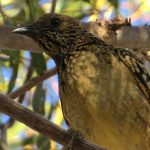WESTERN BOWERBIRD
The Western bowerbird is a medium-sized bird, measuring around 28 to 32 centimetres in length. It has a rather cryptic plumage, with mottled brown and olive-green feathers that provide excellent camouflage in its arid habitat. The male Western bowerbird is particularly striking due to the bright pink to lilac patch of skin on the back of his neck, which he displays prominently during courtship. Both males and females have a stout bill and strong legs, suited to their terrestrial lifestyle.
The Western bowerbird is primarily found in the arid and semi-arid regions of Central and Western Australia. Its range extends across the Northern Territory, Western Australia, and parts of South Australia. These birds prefer habitats such as rocky outcrops, dry woodlands, and shrublands where they can find suitable materials for their bowers.
One of the most remarkable aspects of the Western bowerbird is its breeding behaviour. Males are known for constructing intricate bowers, which are not nests but elaborate structures built to attract females. These bowers are typically made from sticks and are decorated with various colourful objects like berries, shells, and even bits of glass or plastic. The male performs a courtship dance and displays his pink neck patch to entice a female to his bower. Once a female is impressed, she will mate with the male but then build a separate nest to lay her eggs and raise the chicks independently.
Western bowerbirds are omnivorous, with a diet that includes fruits, seeds, insects, and small vertebrates. They are particularly fond of figs and other native fruits. These birds forage both on the ground and in trees, using their keen eyesight to spot food. They are known to be opportunistic feeders, often taking advantage of seasonal abundance in their arid environment.
In the wild, Western bowerbirds can live up to around 8 to 10 years, although this can vary depending on environmental conditions and predation pressures. In captivity, they might live longer due to the absence of predators and consistent food supply.
Western bowerbirds have a diverse range of vocalisations, including whistles, chattering, and mimicry of other bird species. Males are particularly vocal during the breeding season, using their calls to attract females and ward off rival males. Their vocal repertoire adds to the overall allure of their bowers, making them even more attractive to potential mates.
The Western bowerbird holds cultural significance for some Aboriginal communities. In traditional stories and art, the bowerbird is often admired for its creativity and industrious nature. The bird’s behaviour of collecting and arranging objects is sometimes seen as a metaphor for human ingenuity and resourcefulness. Additionally, certain Aboriginal groups might have traditional knowledge about the bird’s habits and its role in the local ecosystem.
While the Western bowerbird is not currently considered endangered, habitat destruction and climate change pose potential threats to its population. Conservation efforts aimed at preserving natural habitats and promoting sustainable land use are crucial for ensuring the long-term survival of this unique and captivating species.




